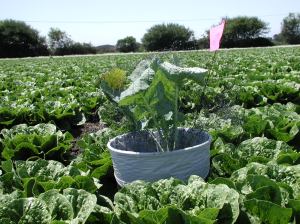I have taken a long hiatus from posting any news or other items on here (for no particularly good reason) and I thought I might try to do some catching up on news from the lab. In the next several posts I will highlight some recent publications and other events over the last half year or so.
First, I would like to highlight a not-so-recent publication (LetBothStire2012 – actually published in 2012) led by collaborators at UC Santa Cruz, PhD student Sara Bothwell Allen and Deborah Letourneau, her advisor. For Sara’s thesis she studied the effects of surrounding land use on parasitism levels of pests and parasitoid diversity in organic agricultural fields in California. She set out “sentinel”  pest caterpillars, confined to their plants, for one week to examine parasitism and she set out Malaise traps for two days (twice per season) to sample parasitoid diversity. She then characterized the surrounding landscape cover using GIS. Because they got quite a few tachinids, Sara and Deborah invited me to collaborate on an analysis of how landscape variables outside the fields affected tachinid diversity and parasitism inside the fields. Interestingly we found effects of many landscape variables on the tachinid fly com
pest caterpillars, confined to their plants, for one week to examine parasitism and she set out Malaise traps for two days (twice per season) to sample parasitoid diversity. She then characterized the surrounding landscape cover using GIS. Because they got quite a few tachinids, Sara and Deborah invited me to collaborate on an analysis of how landscape variables outside the fields affected tachinid diversity and parasitism inside the fields. Interestingly we found effects of many landscape variables on the tachinid fly com
munities in the agricultural fields, but the strongest pattern was an increase in tachinid abundance and diversity with increasing coverage of semi-wild perennial vegetation in the landscape (see graphs below). These results argue for that current trends towards agricultural intensification -plowing fence line to fence line are counterproductive. Semi-wild corridors and fragments can act as refugia for parasitoids, which may reduce the need for pest control measures in organic or conventional agriculture.
